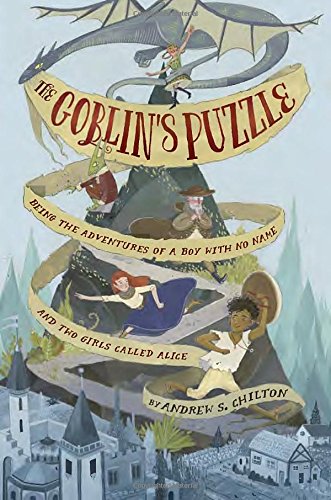The Goblin’s Puzzle: Being the Adventures of a Boy with No Name and Two Girls Called Alice by Andrew S. Chilton.
 I was reminded of the movie and book The Princess Bride while reading this debut middle grade fantasy novel, and that is high praise indeed. For a book to remind one of The Princess Bride, it must be clever in a similar way to the the wit and wisdom of that classic. It is. I can also say that I wanted to see The Goblin’s Puzzle as a film and that I think it could be a good one. Other than The Princess Bride, which may or may not have been an inspiration, Mr. Chilton’s sources seem to be good and quite varied:
I was reminded of the movie and book The Princess Bride while reading this debut middle grade fantasy novel, and that is high praise indeed. For a book to remind one of The Princess Bride, it must be clever in a similar way to the the wit and wisdom of that classic. It is. I can also say that I wanted to see The Goblin’s Puzzle as a film and that I think it could be a good one. Other than The Princess Bride, which may or may not have been an inspiration, Mr. Chilton’s sources seem to be good and quite varied:
From the author’s website at Penguin Random House: “Andrew S. Chilton drew inspiration for The Goblin’s Puzzle from a wide variety of sources, ranging from The Hobbit to Monty Python to Aristotle’s Nicomachean Ethics. As a kid, he gobbled up fantasy novels and logic puzzles, and as an adult, he spent over ten years as a practicing lawyer before launching his career as a writer.”
The book stars a nameless slave boy, a girl called Plain Alice (to distinguish her from all the other Alices in the kingdom), Princess Alice, heir to the throne, and a goblin named (something long and complicated), Mennofar for short. The Boy is running for his life from an unfortunate incident that ended in the violent death of his master’s son. It really wasn’t The Boy’s fault, but it will be blamed on him anyway, and he feels quite guilty about breaking a lot of the 99 rules for being a good slave, most of which he can’t even remember. Meanwhile, Plain Alice, who wants to become a sage but can’t get an opportunity because she’s a girl, has been kidnapped by a dragon. And Princess Alice, who should have been the object of the dragon’s kidnapping, is worrying King Julian, her father, with her frequent giggling and lack of a serious education. The goblin, Mennofar, is running away, too, and he owes The Boy for his help in the goblin’s escape from captivity. But Mennofar is indeed a goblin, and “it is hard for a goblin and a human to be friends. Goblin honor and human honor are so very different.” Mennofar feels obligated to do something for The Boy, but his “goblin honor” also demands that he make the whole thing into a particularly difficult and complicated puzzle.
There’s a afterword to the book that explains a bit about the basics of the study of logic, which is the main theme and framework for the story. But it’s a subtle use of logic, not an in-your-face teaching of logic. (Don’t worry. If you aren’t at all interested in the study of logic, it’s still a great story, and you won’t be tricked into learning logic—much. Although goblins are kind of tricky that way.) I enjoyed the discussions between Mennofar and The Boy and between Plain Alice and the dragon, Ludwig, that were illustrations of the different aspects of logic, which is the study of how we prove things, according to Mr. Chilton. I might have guessed, if I had thought of it, that Mr. Chilton was a lawyer before he decided to write a book for middle grade logicians and fantasy lovers.
I also just liked this story. Do I have to prove that it’s a good book for this to be a good review or for you to believe me when I say that you would probably enjoy it, too? I don’t think so. After all, we’re humans, not goblins. We don’t have to be strictly logical. Or tricky.
The cover screams “Mysterious Benedict Society”!
Pingback: Middle Grade Book Wisdom 2016, Mostly Fantasy | Semicolon